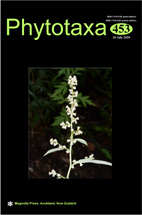Abstract
A new species, Selaginella coriaceifolia, is described and illustrated from central Vietnam. The new species can be distinguished from other species in Asia by its habit epilithic, main stem nearly isotomously branched, leaves strongly leathery, ventral leaves imbricate on stem and branch, dorsal leaves with reflexed arista at apex, and sporophylls nearly monomorphic. Molecular and morphological studies of the new species and its allies in S. subg. Heterostachys Baker sect. Heterostachys (Baker) Li Bing Zhang & X.M.Zhou are conducted.
References
Baker, J.G. (1883) A synopsis of the genus Selaginella. Journal of Botany 21: 1–5, 42–46, 80–84, 97–100, 141–145, 210–213, 240–244.
Baker, J.G. (1885) A synopsis of the genus Selaginella. Journal of Botany 23: 19–25, 45–48, 116–122, 154–157, 176–180, 248–252, 292–302.
Blume, C.L. (1828) Enumeratio Plantarum Javae et Insularum adjacentium. Fasc. II. Van Leeuwen, Leiden.
Chu, W.M. (2006) Selaginellaceae. In: Wu, C.Y. (Ed.) Flora Yunnanica, Vol. 20. Science Press, Beijing, pp. 35–93.
Darriba, D., Taboada, G.L., Doallo, R. & Posada, D. (2012) jModelTest 2: more models, new heuristics and parallel computing. Nature Methods 9: 772–772.
<a href="https://doi.org/10.1038/nmeth.2109">https://doi.org/10.1038/nmeth.2109</a>
Hieronymus, G. (1904) Selaginellarum species novae vel non satis cognitae. II. Selaginellae e subgenere (vel sectione) Heterophyllo (continuatio prima). Hedwigia 43: 1–65.
Jermy, A.C. (1986) Subgeneric names in Selaginella. Fern Gazette 13: 117–118.
Jermy, A.C. (1990) Selaginellaceae. In: Kubitzki, K., Kramer, K.U. & Green, P.S. (Eds.) The Families and Genera of Vascular Plants, Pteridophytes and Gymnosperms, Vol. 1. Springer, Berlin, pp. 39–45.
<a href="https://doi.org/10.1007/978-3-662-02604-5_11">https://doi.org/10.1007/978-3-662-02604-5_11</a>
Linnaeus, C. (1753) Species plantarum, vol. II. Laurentii Salvii, Stockholm, Sweden.
Palisot-Beauvois, A.M.F.J. (1804) Suite de l’Aethéogamie. Magasin Encyclopédique 9: 472–483.
Poiret, J.L.M. (1814) Encyclopeìdie meìthodique. Botanique. Supplement 3. H. Agasse, Paris, pp. 1–780.
https: //doi.org/10.5962/bhl.title.826.
Schulz, C., Homberg, J. & Stutzel, T. (2013) Taxonomic revision of Selaginella subg. Ericetorum. Systematic Botany 38: 5–14.
<a href="https://doi.org/10.1600/036364413X661935">https://doi.org/10.1600/036364413X661935</a>
Shalimov, A.P., Zhu, Y.-M., Zhang, M.-H. & Zhang, X.-C. (2019) Selaginella dianzhongensis (Selaginellaceae), a new spikemoss from China. PhytoKeys 118: 75–87.
<a href="https://doi.org/10.3897/phytokeys.118.30375">https://doi.org/10.3897/phytokeys.118.30375</a>
Singh, S.K., Yadav, B.B., Srivastava, M., Shukla, P.K. & Srivastava, G.K. (2014) Micro-morphology of Selaginella megaspores from India. Grana 53: 197–220.
<a href="https://doi.org/10.1080/00173134.2014.919356">https://doi.org/10.1080/00173134.2014.919356</a>
Spring, A.F. (1838) Beiträge zur Kenntniss der Lycopodien. Flora 21: 145–158, 161–175, 193–222.
Spring, A.F. (1843) Enumeratio Lycopodinearum, quas in ejusdem plantarum ordinis monographia mox edenda descripsit Ant. Spring. Pars Altera. II. Selaginella. Bulletin de l’Académie royale des Science et de lettres et des Beaux-arts de Belgique 10: 134–146.
Spring, A.F. (1850) Monographie de la Famille des Lycopodiacées, Seconde partie, 24. Mémoires de l‘Académie Royales des Sciences, Lettres et Beaux Arts de Belgique, pp. 1–358.
<a href="https://doi.org/10.5962/bhl.title.15539">https://doi.org/10.5962/bhl.title.15539</a>
Thiers, B. (2018) Index Herbariorum: A global directory of public herbaria and associated staff. New York Botanical Garden’s Virtual Herbarium. Available from: http: //sweetgum.nybg.org/science/ih/ (accessed 26 November 2018)
Weststrand, S. & Korall, P. (2016a) A subgeneric classification of Selaginella (Selaginellaceae). American Journal of Botany 103: 2160–2169.
<a href="https://doi.org/10.3732/ajb.1600288">https://doi.org/10.3732/ajb.1600288</a>
Weststrand, S. & Korall, P. (2016b) Phylogeny of Selaginellaceae: There is value in morphology after all! American Journal of Botany 103: 2136–2159.
<a href="https://doi.org/10.3732/ajb.1600156">https://doi.org/10.3732/ajb.1600156</a>
Wu, Y.-D., Zhang, H.-R. & Zhang, X.-C. (2017) Selaginella guihaia (Selaginellaceae): A new spikemoss species from southern China and northern Vietnam around the Gulf of Tonkin. PhytoKeys 80: 41–52.
<a href="https://doi.org/10.3897/phytokeys.80.11126">https://doi.org/10.3897/phytokeys.80.11126</a>
Zhang, X.-C., Nooteboom, H.P. & Kato, M. (2013) Selaginellaceae. In: Wu, Z.-Y., Raven, P.H. & Hong, D.-Y. (Eds.) Flora of China. Science Press, Beijing and Missouri Botanical Garden Press, St. Louis, Vol. 2–3: 37–66.
Zhou, X.-M., He, Z.-R., Zhang, L. & Zhang, L.-B. (2015a) Selaginella chuweimingii (Selaginellaceae) sp. nov. from Yunnan, China. Phytotaxa 231 (3): 283–288.
<a href="http://dx.doi.org/10.11646/phytotaxa.231.3.6">http://dx.doi.org/10.11646/phytotaxa.231.3.6</a>
Zhou, X.-M., Jiang, L.-J., Zhang, L., Gao, X.-F., He, Z.-R. & Zhang, L.-B. (2015b) Spore morphology of Selaginella (Selaginellaceae) from China and its systematic significance. Phytotaxa 237 (1): 1–67.
<a href="http://dx.doi.org/10.11646/phytotaxa.237.1.1">http://dx.doi.org/10.11646/phytotaxa.237.1.1</a>
Zhou, X.-M., Rothfels, C.J., Zhang, L., He, Z.-R., Le Péchon, T., He, H., Lu, N.T., Knapp R., Lorence, D., He, X.-J., Gao, X.-F. & Zhang, L.-B. (2016) A large-scale phylogeny of the lycophyte genus Selaginella (Selaginellaceae: Lycopodiopsida) based on plastid and nuclear loci. Cladistics 32: 360–389.
<a href="https://doi.org/10.1111/cla.12136">https://doi.org/10.1111/cla.12136</a>
Zhou, X.-M. & Zhang, L.-B. (2015) A classification of Selaginella (Selaginellaceae) based on molecular (chloroplast and nuclear), macromorphological, and spore features. Taxon 64: 1117–1140.
<a href="https://doi.org/10.12705/646.2">https://doi.org/10.12705/646.2</a>

